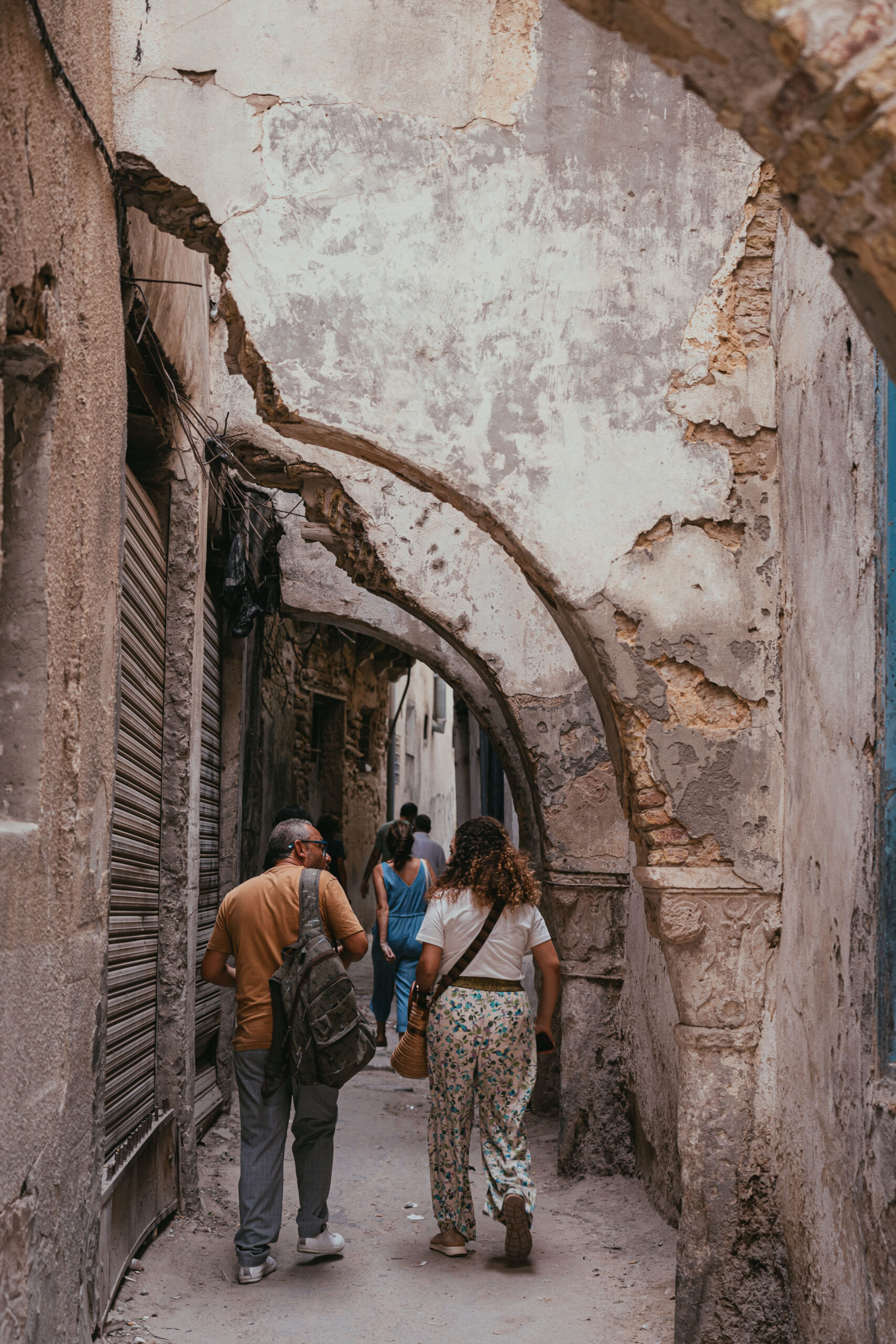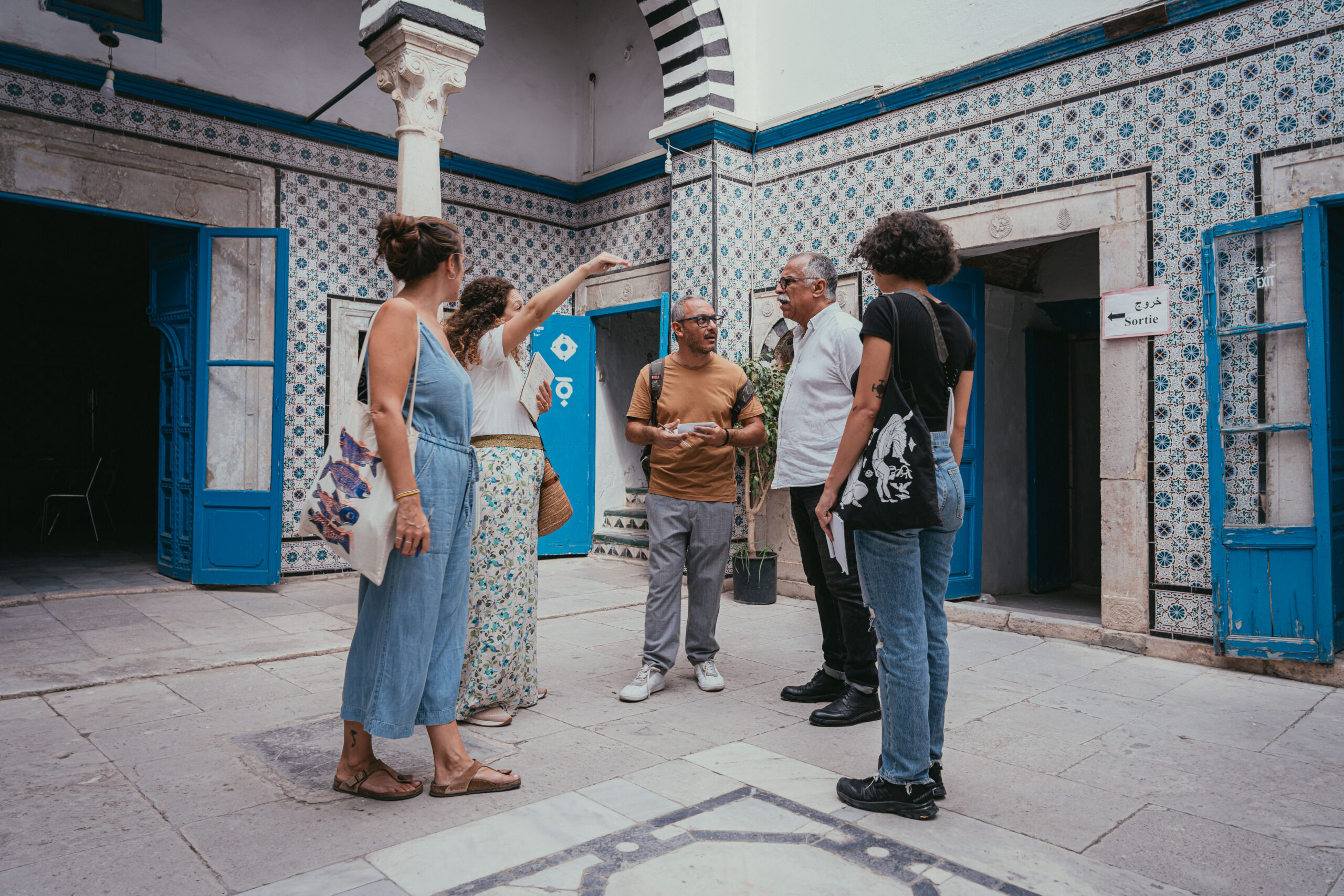Hi Camille ! First, can you introduce your organization?
L’Art Rue is a Tunisian organization situated in the historic Medina of Tunis, a district dating back to the 7th century. Amidst the public spaces, numerous intriguing locations, including old palaces and houses, remain inaccessible to the public. For the past 15 years, L’Art Rue has been organizing the biennial festival Dream City, aiming to showcase artistic projects in both public spaces and unconventional locations within the Medina. Over time, the organization has expanded its initiatives, incorporating artistic residencies, workshops, and activities involving youth and children from the Medina and Tunis.
What were the motivations for embarking on the Slash Transition project?
We were intrigued by the realm of sound art. At L’Art Rue, our approach predominantly leans towards multidisciplinarity, with a primary focus on the performing arts rather than music and sound art. Another motivation was to explore the Medina from a fresh perspective. The Medina, with its vastness encompassing approximately 110,000 inhabitants and 270 hectares, constantly offers new angles, through sound for example. We had already carried out projects based on the sound of crafts in the Medina, things like that, but it was really specific.
What is distinctive about this region in cultural and artistic terms, and how does your organization fit into this local ecosystem?
The Medina is a city within a city. It doesn’t function like the rest of Tunis.There are almost no cars, the streets are super narrow with a lot of proximity between people, the buildings are lower and older, and the sound environment is quite specific. When you go to the Medina, you immediately feel like you have entered another world. I think Dream City and L’Art Rue are the first major initiatives focusing on the Medina and the potential of its diversity. You see a small door, you enter, and it is an incredible space with a large courtyard, sometimes even two courtyards, with ceramics on all the walls, lots of space, and acoustic potential. We programme a lot of performances and installations in this kind of space. Other organizations have since emerged , but considering the size of Medina and its population, their numbers remain small.
With regard to your local hub, who were the members? What was their initial reaction to the project?
The specificity of our local hub is that we only work with individuals and not organizations. They all have a professional and personal connection to the Medina. There is the former director of one of the public heritage organizations, but his contribution is mainly due to the fact that he lives in the Medina and knows its history very well. He knows a lot of amusing facts and stories that we have heard for the first time at our meetings. The local hub includes architects and historians of the Medina, sound artists, and a visually impaired singer with a unique perception of sound and space. There is also a music producer, a musicologist and researchers who have already made studies about the Medina’s 19th-century soundscape. They are people with their own personalities, but they don’t represent an organization or specific interests. This configuration creates a pleasant dynamic within the discussion.
How did you define the experimental territory for the artist-in-residency?
We came up with the different “uses” of the Medina. And we came up with three main themes. The theme of sacredness is prominent in the district as it includes a multitude of mosques, spiritual and sacred places. There are also what you might call ritual habits, something between medicinal and spiritual activities, like stores selling lots of plants and herbs for making mixtures and remedies. The second focus we will propose are the commercial parts of the Medina. In this type of area, you’ll find cafés, restaurants and markets. The last type of areas are the residential ones with no stores, no cafés, just homes.
Can you elaborate on how the concept of transition is reflected in these areas?
In all three themes, the concept of transition emerged because the architecture reflects the roles and functions of the district. Above all, specific sound characterizes each era of the Medina. For example, spiritual places have their own soundscape. As for the residential part, the streets are very narrow, so you can walk down the street and hear what is happening in someone’s house. The same goes for the shopping areas and markets, crowded with young people drinking tea, craftspeople, people doing copper sculptures, etc. There is also the idea of transition between those three roles, when walking in the Medina, you constantly go from one to the other, experiencing a radical change of scenery or sound in just a few seconds.
Is there any connection with the public policies and urban development in the way you have identified the different areas of The Medina?
In comparison to some of the other partners involved in this project, Tunis faces a unique challenge in terms of urban development. The city does not have any public funds dedicated to urban development, especially in the Medina. Only two public organizations are responsible for heritage preservation, and even they have limited funds and are focused on restoring specific old buildings. This means that there is no urban policy for streets, squares, or waste management in the Medina. As a result, the transitions in the Medina are not driven by public development but rather by other factors. To address this issue, we have decided to take a topic-based approach to identify transitions.
How will you concretely present these different aspects to the foreign artist in residence with L'Art Rue in the Medina?
We were scheduled to have five meetings with the local hub, but we have decided to hold one additional meeting to plan out an itinerary through the Medina based on the themes we have identified. Our aim is to propose various routes starting from some notable spots such as buildings, squares, and cafes. We intend to create one itinerary for the day and another for the night. We believe that the time dimension is significant since one can go through specific places at different times of the day, and it will feel like two different worlds. We want to keep this itinerary as flexible as possible, but we will provide some reference points to help the artist discover the vast diversity of the Medina.
Which topics have generated shared opinions? And others that have divided the group?
We quickly agreed on the three themes mentioned earlier. There were different opinions about the final brief. The first idea was to provide themes, subjects, and as much material as possible to the artist and residency, including pre-recorded sounds and location specifications. However, the three artists in the group did not agree with this approach as working with pre-recorded sound could be too limiting from their point of view. It’s difficult to imagine how someone visiting the Medina for the first time would manage all this. We need to strike a balance, giving enough context without being too influential and allowing exploration.
Is there anything else you'd like to add to this interview that we haven't discussed?
After completing two months of Slash Transition and gaining experience from other cooperative projects, I believe that initiating a project with a territorial approach and sharing it with all partners is an excellent way for each participant to gain a deeper understanding of the territory and organization of the other partners. This approach will help avoid any misunderstandings that may arise, as has happened in the past with other projects. I am delighted that we are doing this work to better understand the whole context.

Local Hub members: : Adnen El Ghali (architect, urban planner, historian of the Médina), Chira Chtara (Architect, research on the soundscapes of the Medina of Tunis in the 19th century), Mohsen Ben Hadj Salem (Architect, researcher), Oussama Menchaoui (sound artist, sound engineer), Ikbal Hamzaoui (musicologist, director of the musicology department at the Institut Supérieur de Musique in Tunis) , Alia Sellami (singer, sound artist), Sonia Kallel (visual artist), Zoubeir Mouhli (architect and urban planner, former director of the Association de Sauvegarde de la Médina), Medhi Ahmadi (composer, founder of Wild Bohemia Studio).
Interview by Cécile Moroux

